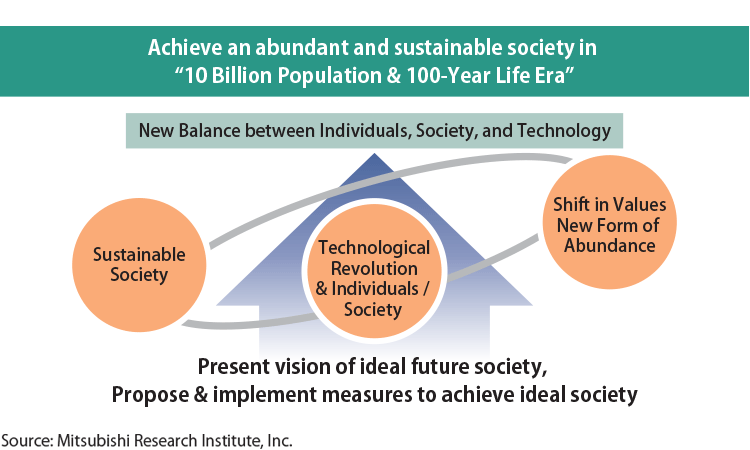As a part of the 50th anniversary of its founding, Mitsubishi Research Institute (MRI) has commenced research to develop a vision of and transition design for achieving the ideal future society 50 years from now. This world, in the latter half of the 21st century, is forecast to reach a population of 10 billion, while at the same time see an increase in the proportion of those over 100 years old, especially in developed countries including Japan. Before the arrival of such an era, we must set goals and make sure progress in resolving the issues already facing the world and humanity today, such as climate change and social polarization & segregation.
Hope can be found in the rapid advancements in high technology including artificial intelligence (AI) and biotechnology. The exponential progress in advancements to digital technologies will make possible economic growth independent of physical resources and bring abundance in a world of 10 billion people. Biotechnology and robotics enhance the biological capabilities of humanity and will facilitate healthy life beyond 100 years. In the process, it is essential to appropriately control the capabilities of AI and robots that vastly surpass those of humans and maintain a balance between technological revolution and humanity, including existence and ethics. Such efforts require a gathering of wisdom spanning a wide range of disciplines.
50 years ago, in the face of the first oil shock and the shift of the US dollar to a floating exchange rate, the global economy was on the verge of major change. The Limits to Growth, published by the Club of Rome in 1972, warned that unless zero growth in both the population and economy was achieved, humanity would fall into a state of danger. The world has not yet fallen into such a state, but continued measures are nevertheless essential. In the 21st century, as physical abundance has saturated developed nations and developing nations have made steady progress in catching up, the "limit to growth" depends not on the amount of physical goods but whether or not the qualitative desires of humanity are met free from disparity.
The Sustainable Development Goals (SDGs), adopted by the United Nations to be achieved by 2030 and with the aim of leaving no one behind, are gaining steam among the private sector. As a measure to address global warming, the Paris Agreement was adopted with the goal of cutting greenhouse gases by 80% in 2050. MRI will re-examine the obstacles for humanity and the world in realizing an abundant and sustainable society before the "10 Billion Population & 100-Year Life Era" in 2070. MRI's mission for the new Japanese Era "Reiwa" is to present and contribute to the realization of solutions to the issues in which Japan is the first in the world to face, including the decease and hyperaging of its population.
Hope can be found in the rapid advancements in high technology including artificial intelligence (AI) and biotechnology. The exponential progress in advancements to digital technologies will make possible economic growth independent of physical resources and bring abundance in a world of 10 billion people. Biotechnology and robotics enhance the biological capabilities of humanity and will facilitate healthy life beyond 100 years. In the process, it is essential to appropriately control the capabilities of AI and robots that vastly surpass those of humans and maintain a balance between technological revolution and humanity, including existence and ethics. Such efforts require a gathering of wisdom spanning a wide range of disciplines.
50 years ago, in the face of the first oil shock and the shift of the US dollar to a floating exchange rate, the global economy was on the verge of major change. The Limits to Growth, published by the Club of Rome in 1972, warned that unless zero growth in both the population and economy was achieved, humanity would fall into a state of danger. The world has not yet fallen into such a state, but continued measures are nevertheless essential. In the 21st century, as physical abundance has saturated developed nations and developing nations have made steady progress in catching up, the "limit to growth" depends not on the amount of physical goods but whether or not the qualitative desires of humanity are met free from disparity.
The Sustainable Development Goals (SDGs), adopted by the United Nations to be achieved by 2030 and with the aim of leaving no one behind, are gaining steam among the private sector. As a measure to address global warming, the Paris Agreement was adopted with the goal of cutting greenhouse gases by 80% in 2050. MRI will re-examine the obstacles for humanity and the world in realizing an abundant and sustainable society before the "10 Billion Population & 100-Year Life Era" in 2070. MRI's mission for the new Japanese Era "Reiwa" is to present and contribute to the realization of solutions to the issues in which Japan is the first in the world to face, including the decease and hyperaging of its population.
Diagram: Overview of 50th Anniversary Research Project

